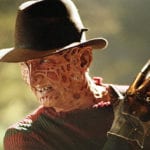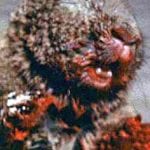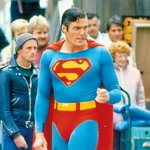 Weird Stuff
Weird Stuff  Weird Stuff
Weird Stuff  Our World
Our World 10 Ways Your Christmas Tree Is More Lit Than You Think
 Movies and TV
Movies and TV The 10 Coolest Stars to Set Sail on The Love Boat
 History
History 10 Things You Didn’t Know About the American National Anthem
 Technology
Technology Top 10 Everyday Tech Buzzwords That Hide a Darker Past
 Humans
Humans 10 Everyday Human Behaviors That Are Actually Survival Instincts
 Animals
Animals 10 Animals That Humiliated and Harmed Historical Leaders
 History
History 10 Most Influential Protests in Modern History
 Creepy
Creepy 10 More Representations of Death from Myth, Legend, and Folktale
 Technology
Technology 10 Scientific Breakthroughs of 2025 That’ll Change Everything
 Weird Stuff
Weird Stuff Ten Bizarre Facts About The Doge Meme
 Our World
Our World 10 Ways Your Christmas Tree Is More Lit Than You Think
 Movies and TV
Movies and TV The 10 Coolest Stars to Set Sail on The Love Boat
Who's Behind Listverse?

Jamie Frater
Head Editor
Jamie founded Listverse due to an insatiable desire to share fascinating, obscure, and bizarre facts. He has been a guest speaker on numerous national radio and television stations and is a five time published author.
More About Us History
History 10 Things You Didn’t Know About the American National Anthem
 Technology
Technology Top 10 Everyday Tech Buzzwords That Hide a Darker Past
 Humans
Humans 10 Everyday Human Behaviors That Are Actually Survival Instincts
 Animals
Animals 10 Animals That Humiliated and Harmed Historical Leaders
 History
History 10 Most Influential Protests in Modern History
 Creepy
Creepy 10 More Representations of Death from Myth, Legend, and Folktale
 Technology
Technology 10 Scientific Breakthroughs of 2025 That’ll Change Everything
10 Iconic Low Budget Horror Films
You don’t need a lot of money to scare someone, but you do need a lot of money to make a film. Today your average run-of-the-mill studio productions will typically cost millions if not tens of millions of dollars, and even B-movies will often put studios back a few hundred thousand.
Horror films have built a reputation for utilizing lower budgets to great effect. But it’s only once in a while that these films see significant returns on their comparatively modest budgets. The movies on this list are those films. And while their budgets may seem large to the average person, these movies stand as feats of frugal ingenuity that surpassed all expectations in the film world.
Related: Top 10 Lamest Horror Movies That Should Have Been Terrifying
10 Night of the Living Dead (1968)
George A Romero’s Night of the Living Dead wasn’t the first zombie film ever made (that distinction most likely goes to Victor Halperin’s White Zombie), but it pretty much created the blueprint for the genre going forward. And to put it plainly, every zombie movie, game, or book of the last fifty-plus years owes it a debt.
The film proved to be a trailblazer in other ways too. It presented previously unseen levels of violence, gore, and terror to audiences, and it was one of the first horror films to cast a black lead in Duane Jones. All things that proved controversial in the eyes of some at the time.
Its towering influence aside, Night of the Living Dead also proved to be a spectacular financial success, eventually bringing in around $30 million worldwide off a modest production budget of $114,000.[1]
9 Psycho (1960)
Another ’60s movie that presented unheard-of levels of violence (and also, in this case, semi-nudity) for a mainstream film at the time was Psycho. Again, the result changed ideas on what could and couldn’t be done on film and inspired generations of filmmakers. The 45-second shower scene pushed the censorship boundaries of the films from the age… as well as the audience’s limits. It remains one of the most famous scenes in movie history.
What’s more, it did all of this with relatively little funding. Indeed, with a budget of $800,000 ($7 million today), Psycho was the lowest-cost film of director Hitchcock’s career. But the story of a murderous man with an unhealthy attachment to his mother may well be his most iconic nonetheless.[2]
8 Tetsuo: The Iron Man (1989)
So an argument could certainly be made that Tetsuo: The Iron Man isn’t quite well known enough to be considered iconic. But, while it might be the least well-known film on this list, it’s also the cheapest by far. And the fact that this film was even possible on its $17,000 budget, let alone able to become a cult-classic worldwide, is a testament to its director’s fortitude.
Told by nearly everyone, including his family members, that making a film was essentially a ridiculous pipedream, Shinya Tsukamoto self-financed his film entirely from savings he made from his day job. And with little cash to go around, Tsukamoto relied upon underground theatre performers and friends to fill out his cast and crew. Luckily for him, one of his actors, Kei Fujiwara, allowed the team to use her apartment as one of the primary locations for the film.
Filming conditions were, by all accounts, both rudimentary and awful to work in. As a result, many cast and crew members abandoned the project during filming. Still, Tsukamoto got his film made, and it soon became an underground sensation that is still influencing filmmakers today.[3]
7 Eraserhead (1977)
Much like Tetsuo, Eraserhead is another totally bizarre film, this time by the king of surrealist filmmaking, David Lynch. But while he might be an icon of the film industry today, Lynch didn’t have the easiest time getting his horror film made back in the 1970s, which had an initial budget of less than $100,000.
Lynch’s problems allegedly began due to backers’ confusion regarding what they were funding. That’s because Lynch’s original script for Eraserhead was only 21 pages long, leaving investors assuming the project would be a short 20-minute film. As a result, Lynch soon found himself constantly running out of money during filming. And things got progressively worse when Lynch split from his wife, became effectively homeless, and started illegally living on set.
The film was ultimately kept alive by loans from friends and Lynch resorting to offering cuts of the film’s profits instead of paying actors. However, it worked out for all involved in the end because the film has gone on to be a surrealist-horror classic with reported earnings of over $7 million.[4]
6 Friday the 13th (1980)
According to writer Victor Miller, director Cunningham envisioned the original Friday the 13th as a cheap and quick cash grab designed to coattail the success of Halloween (1978). Whether or not that is true, few could have predicted that this low-budget film about a mysterious killer murdering teenagers at a holiday camp would have just as significant an effect on the genre as its apparent inspiration. And fewer still would have predicted that this $550,000 production would bring in over $59,000,000 and spawn one of the most profitable horror franchises of all time.[5]
5 The Texas Chainsaw Massacre (1974)
The Texas Chainsaw Massacre may be decades old, but this horror flick about a chainsaw-wielding lunatic and his deranged family still looks and feels every bit as nasty today as it did in 1974. And the fact that the film was made on a measly $60,000 only shows that visceral horror will always trump CGI tricks and effects when it comes to terrifying audiences.
As impressive as that is, you have to feel for everyone who worked on making this film a reality. Because, by all accounts, filming The Texas Chainsaw Massacre was a miserable experience. Not only did the cast and crew have to deal with the scorching Texas heat, but they had to do so while working with the stench caused by decaying animal corpses, blood, and bones. Furthermore, the tight budget meant that the cast had to wear the same filthy clothes daily for continuity purposes, and several real-life injuries occurred on set due to faulty props. “Everyone hated me by the end of the production.” director Tobe Hooper would later reveal, “It just took years for them to kind of cool off.”[6]
4 Evil Dead (1981)
When the trio of Bruce Campbell, Sami Raimi, and Robert Tapert put their creative minds together to start making horror shorts in the ’70s, making an entire feature-length film was more of a pipe dream than anything. Not only did they not have the money for such a venture, but they didn’t exactly have the credentials either. As Bruce Campbell would later write in If Chins Could Kill: “Three guys with no professional experience, questionable education, and a dream to make a film in Detroit wouldn’t exactly make the average investor dive into his pocketbook.”
However, after filming a $1,600 short titled
The trio eventually managed to gather approximately $375,000 to make their film, Evil Dead. Undoubtedly an impressive feat but still a tight budget for a horror flick. Nonetheless, thanks to some creative ingenuity, the resulting film was a hit with horror fans and inevitably launched a franchise that continues decades later.[7]
3 Halloween (1978)
When discussing the most famous horror film of all time, Halloween will almost always be involved in the debate. But this film that managed to bring in over $70 million worldwide and launch one of horror’s biggest franchises started with a budget of only $325,000.
Budget constraints weren’t the only challenge filmmakers had to overcome while filming Halloween. There was also an issue regarding location. That is because while the film takes place in middle America during autumn, the shooting occurred in Southern California in May. To overcome this, the team would throw bags of hand-painted leaves around before each outdoor shot. But, if you look closely, you can still identify a few tell-tale palm trees during certain scenes.[8]
2 Paranormal Activity (2007)
In the early 2000s, soon-to-be filmmaker Oren Peli and his girlfriend had just moved into their new San Diego flat when the couple began hearing strange noises at night. These noises were so peculiar that Peli considered putting up some cameras to try and discover their source. Although he never got round to it, the thought inspired an idea for a film that would become Paranormal Activity.
With a production budget of just $15,000, Peli filmed Paranormal Activity almost entirely within his own house, working with a pair of then-unknown actors, Katie Featherston and Micah Sloat. The storyline and effects were about as bare bones as you can get, but Peli used this to his advantage to create a film that felt realistic, unsettling, and novel (at the time). As such, it left audiences terrified, with even Stephen Speilberg reportedly being left genuinely spooked after watching the film.
Today, the Paranormal Activity franchise and the many copycats it inspired have arguably run out of steam. Nonetheless, Peli’s small-budget flick became one of the most profitable ever, bringing in around $200 million worldwide.[9]
1 The Blair Witch Project (1999)
The Blair Witch Project was by no means the first found footage film nor the first mockumentary. But it is nonetheless the first to popularize the genres. And, thanks to a clever online marketing campaign, it remains one of the only horror films in history to make a good go at tricking audiences into questioning whether what they saw was real.
Created by Daniel Myrick and Eduardo Sánchez, the film tells the story of three student filmmakers who get lost in the woods while making a documentary about a local legend, the Blair Witch. The film, shot for around $60.000 (though post-production brought that number to approximately $200,000), features little in the way of effects or gore to scare audiences. Instead, it relies on suspense and a sense of realism to get under their skin. And while modern audiences might find it a little tame, it worked just like a charm back in 1999, eventually making around $249 million globally.[10]








